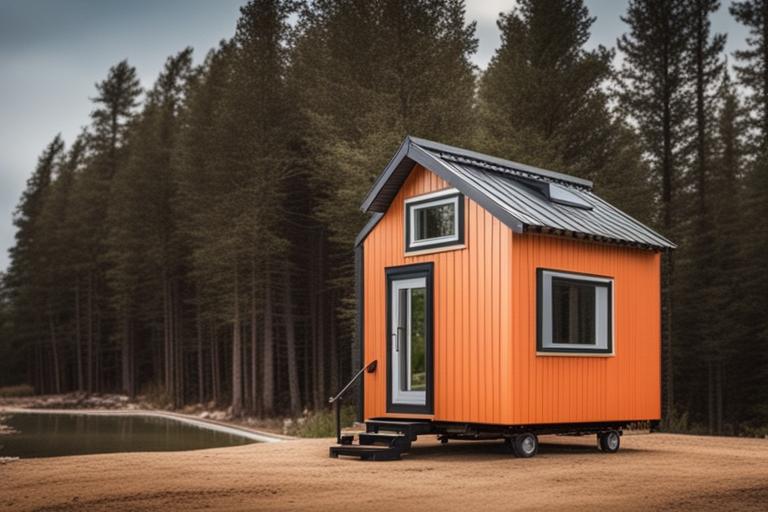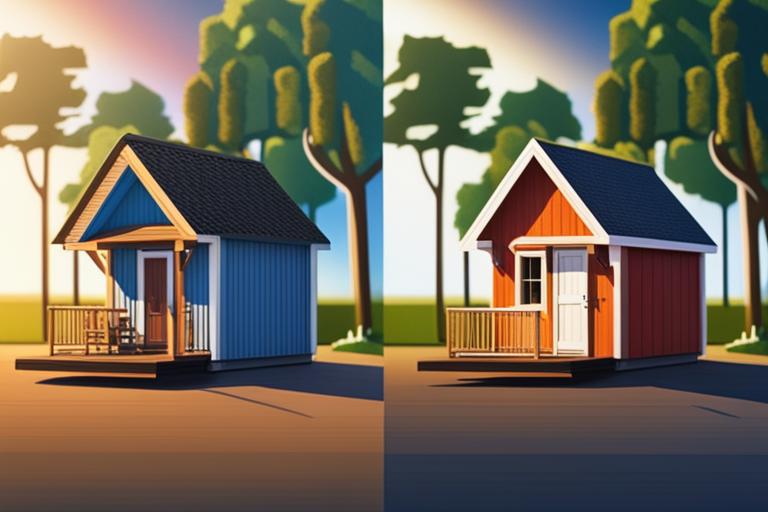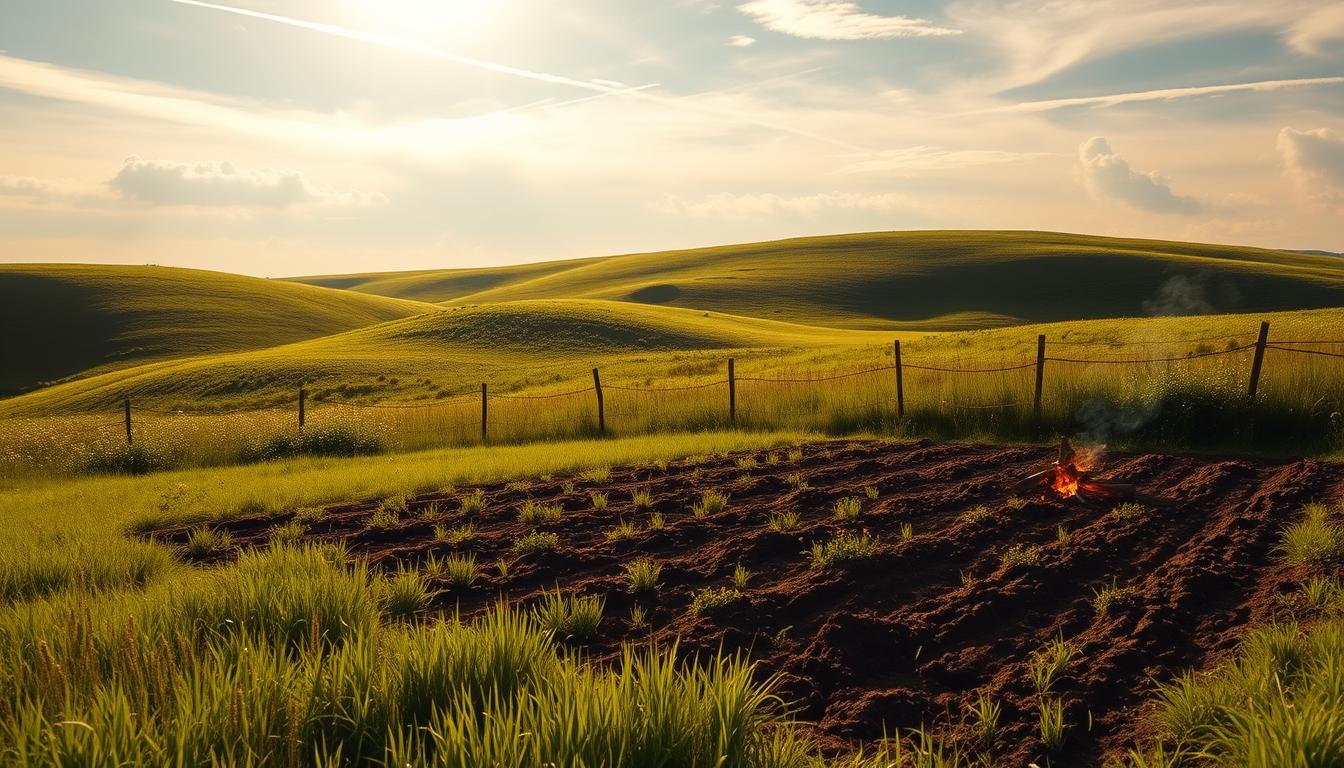What you will learn about tiny house land rental
- Options for finding land for rent, including private landowners, tiny house communities, and online platforms.
- Factors to consider when searching for land, such as location, zoning laws, and accessibility.
- Responsibilities and obligations for both the landowner and the tiny house renter.

Definition and Overview of Tiny House Land Rental
Tiny house land rental refers to the practice of renting a piece of land or property to park and live in a tiny house. A tiny house is a small, compact dwelling typically ranging from 100 to 400 square feet in size. This housing option has gained popularity in recent years due to its affordability, sustainability, and minimalistic lifestyle appeal.
Are you interested in living in a tiny house but don’t want to commit to purchasing land? Renting land for a tiny house might be the perfect solution for you. This comprehensive guide will provide you with all the information you need to know about tiny house land rental, including its benefits, challenges, and how to find suitable land.

Exploring the Benefits and Challenges of Renting Land for Tiny Houses
Renting land for a tiny house comes with its own set of advantages and challenges. Let’s explore both:
Benefits of Renting Land for Tiny Houses
- Affordability: Renting land for a tiny house is often more affordable than buying land or a traditional house. The lower cost of living can free up resources for other financial goals or pursuits.
- Flexibility and Mobility: Renting land allows for the flexibility to move your tiny house to different locations if desired. This mobility can be especially appealing for those who enjoy exploring new areas or living a more nomadic lifestyle.
- Reduced Environmental Impact: Tiny houses are known for their eco-friendly design and reduced environmental footprint. By renting land, individuals can minimize their impact on the environment while still enjoying the benefits of tiny house living.
- Sense of Community: Many tiny house communities and co-housing projects offer the opportunity to connect with like-minded individuals who share similar values and lifestyles. Living in close proximity to others can foster a strong sense of community and provide a supportive network.
Challenges of Renting Land for Tiny Houses
- Limited Availability: Finding suitable land for tiny house rental can be challenging, especially in areas with strict zoning laws and regulations. The demand for affordable housing options has increased the competition for available land, making it important to thoroughly research and explore different options.
- Zoning Laws and Regulations: Zoning laws and regulations vary by location and can significantly impact the feasibility of renting land for a tiny house. It is essential to understand and comply with these laws to avoid potential legal issues or conflicts with local authorities.
- Maintenance and Upkeep: While renting land for a tiny house eliminates the responsibility of property maintenance, tenants are still responsible for maintaining the condition and cleanliness of their tiny house. This includes regular cleaning, repairs, and adhering to any community guidelines or rules.
- Limited Space: Tiny houses are designed to maximize space efficiency, but they still have limited living space compared to traditional homes. Renters must carefully consider their lifestyle needs and ensure that a tiny house meets their requirements for comfort and functionality.

Finding Suitable Land for Tiny House Rental
Options for Finding Land for Rent
When searching for land to rent for a tiny house, there are several options to consider. These include:
1. Private Landowners and Homeowners
Approaching private landowners or homeowners who have extra land available for rent can be a great starting point. This option allows for more flexibility and negotiation in terms of rental terms and agreements. Networking within local communities, attending tiny house events, or utilizing online classifieds can help connect with potential landowners.
2. Tiny House Communities and Co-housing Projects
Tiny house communities and co-housing projects are specifically designed to accommodate tiny houses and foster a sense of community. These communities often provide shared amenities, such as communal gardens, laundry facilities, and recreational spaces. Joining an existing community or exploring new ones can offer a supportive and like-minded environment for tiny house living.
3. Online Platforms and Rental Marketplaces
Utilizing online platforms and rental marketplaces can be a convenient and efficient way to find available land for rent. Websites and apps dedicated to tiny house rentals, such as TinyHouseLandRental.com and RentingLandForTinyHouse.com, connect renters with landowners looking to lease their property for tiny house purposes. These platforms often provide search filters for location, price range, and specific requirements.
Factors to Consider When Searching for Land
When searching for land to rent for a tiny house, several factors should be considered to ensure a suitable and enjoyable living experience. These factors include:
1. Location and Proximity to Amenities
Consider the location of the land and its proximity to essential amenities such as grocery stores, healthcare facilities, schools, and public transportation. Assessing the distance to these amenities can help determine the convenience and practicality of the location for daily living.
2. Zoning Laws, Regulations, and Permits
Before finalizing any rental agreement, it is crucial to thoroughly research and understand the local zoning laws, regulations, and permits related to tiny houses. Certain areas may have specific restrictions or requirements that must be met to legally park and live in a tiny house.
3. Size, Suitability, and Accessibility of the Land
Evaluate the size and suitability of the land for a tiny house. Consider factors such as the terrain, soil condition, and any potential hazards that may affect the placement and stability of the tiny house. Additionally, assess the accessibility of the land, including road conditions and ease of entry and exit.

Researching Zoning Laws and Regulations
Importance of Understanding Local Zoning Laws and Regulations
Understanding and complying with local zoning laws and regulations is crucial when renting land for a tiny house. Zoning laws determine how land can be used and what types of structures can be built on it. Violating zoning laws can result in fines, eviction, or legal complications. Therefore, it is essential to research and familiarize yourself with the specific zoning requirements in the area where you plan to rent land.
Researching Permits, Building Codes, and Legal Requirements
In addition to zoning laws, it is important to research any necessary permits, building codes, and legal requirements when renting land for a tiny house. Different jurisdictions may have specific regulations regarding the construction, placement, and occupancy of tiny houses. Contact local authorities, such as the building department or planning commission, to inquire about the necessary permits and legal obligations.
Tips for Navigating Zoning Codes and Obtaining Necessary Approvals
Navigating zoning codes and obtaining necessary approvals for tiny house rental can be challenging. Here are some tips to help streamline the process:
- Consult with Professionals: Seek guidance from professionals who are familiar with local zoning laws and regulations. Architects, land use attorneys, or experienced contractors can provide valuable insights and help navigate the complexities of zoning codes.
- Attend Local Meetings and Workshops: Participate in local meetings or workshops related to tiny house living or sustainable housing initiatives. These events often provide opportunities to learn from experts, connect with like-minded individuals, and gain a better understanding of the local landscape.
- Engage in Community Outreach: Engaging with the local community and building positive relationships can help garner support for tiny house initiatives. Attend neighborhood association meetings, share information about the benefits of tiny houses, and address any concerns or misconceptions that may arise.
- Collaborate with Landowners: Collaborate with landowners to ensure that the rented land is compliant with local regulations. This may involve working together to obtain necessary permits or modifications to the property to meet zoning requirements.

Negotiating Rental Terms and Agreements
Importance of Clear Rental Agreements and Contracts
Clear and well-defined rental agreements and contracts are essential when renting land for a tiny house. These documents outline the rights and responsibilities of both the landowner and the tenant, minimizing the potential for misunderstandings or disputes.
Discussing Lease Terms, Duration, and Rental Rates
When negotiating rental terms, discuss lease duration, rental rates, and any potential rent increases over time. Clarify whether the rental arrangement is month-to-month or for a fixed period. Understanding the terms and conditions upfront can help establish a mutually beneficial agreement.
Utilities, Amenities, and Maintenance Responsibilities
Discuss utilities and amenities available on the rented land. Determine which utilities are included in the rental rate and which are the responsibility of the tenant. Additionally, clarify maintenance responsibilities for both the land and the tiny house to avoid confusion or conflicts down the line.
Restrictions, Rules, and Shared Spaces within a Community Setting
If renting land in a community setting, discuss any restrictions, rules, or guidelines that tenants must adhere to. This may include restrictions on pets, noise levels, or the use of shared spaces. Understanding and respecting these rules is crucial for maintaining a harmonious living environment.
Inspecting the Land and Assessing Suitability
Importance of Physically Inspecting the Land Before Renting
Before finalizing the rental agreement, it is crucial to physically inspect the land to ensure its suitability for a tiny house. Pictures and descriptions may not capture all the necessary details, so a site visit is highly recommended.
Checklist for Land Inspection and Assessing Suitability
When inspecting the land, consider the following factors to assess its suitability for a tiny house:
1. Access, Parking, and Road Conditions
Evaluate the accessibility of the land. Assess the condition of the access roads, parking options for the tiny house, and any potential obstacles or limitations that may affect maneuverability.
2. Utilities, Infrastructure, and Hook-up Options
Check the availability and condition of utilities such as water, electricity, and sewage. Determine if the land has existing infrastructure or if hook-up options are available. Understanding these factors is essential for planning and budgeting.
3. Proximity to Amenities, Services, and Transportation
Consider the proximity of the land to essential amenities, services, and transportation. Evaluate the distance to grocery stores, healthcare facilities, schools, and public transportation options. This will help determine the convenience and practicality of the location for daily living.
Understanding Responsibilities and Obligations
Responsibilities of the Landowner or Property Manager
Landowners or property managers have specific responsibilities when renting land for a tiny house. These may include:
1. Maintenance, Repairs, and Landscaping
Landowners are typically responsible for maintaining the land, including any landscaping, repairs, or improvements. Clarify these responsibilities in the rental agreement to ensure a well-maintained living environment.
2. Insurance Coverage and Liability Considerations
Landowners should have appropriate insurance coverage for the property, including liability coverage. This protects them from potential accidents or damages that may occur on the premises. Tenants should inquire about the landowner’s insurance coverage and consider obtaining renter’s insurance for their personal belongings.
Responsibilities of the Tiny House Renter or Occupant
As a tenant or occupant of a rented tiny house, you have certain responsibilities to uphold. These may include:
1. Maintenance, Cleanliness, and Safety of the Tiny House
Tenants are responsible for the maintenance, cleanliness, and safety of their tiny house. This includes regular cleaning, minor repairs, and ensuring that the tiny house meets all necessary safety requirements.
2. Waste Disposal, Recycling, and Environmental Considerations
Proper waste disposal and recycling practices are the responsibility of the tenant. Familiarize yourself with local waste management guidelines and adhere to them. Additionally, consider implementing eco-friendly practices such as composting and minimizing energy consumption.
3. Adherence to Community Guidelines and Shared Responsibilities
If residing in a community setting, tenants must adhere to community guidelines and shared responsibilities. This may include participating in communal activities, contributing to the maintenance of shared spaces, and respecting the privacy and boundaries of fellow community members.
Building a Positive Relationship with the Landowner
Importance of Open Communication and Mutual Respect
Building a positive relationship with the landowner is essential for a successful and enjoyable living experience. Open communication and mutual respect form the foundation of this relationship. Regularly communicate with the landowner, addressing any concerns or issues promptly and respectfully.
Respecting the Landowner’s Property, Privacy, and Rules
Respect the landowner’s property by adhering to any rules or guidelines established by the landowner or the community. Respect their privacy and avoid encroaching on areas that are designated as private or off-limits. Being a considerate tenant fosters a harmonious living environment.
Strategies for Conflict Resolution and Addressing Concerns
In the event of conflicts or concerns, employ effective strategies for conflict resolution. Approach disagreements with an open mind, seeking compromise and understanding. If necessary, involve a neutral third party, such as a mediator, to help facilitate communication and find mutually agreeable solutions.
Ensuring Legal Protection and Compliance
Importance of Written Agreements, Contracts, and Documentation
To ensure legal protection and compliance, it is crucial to have written agreements, contracts, and documentation in place. These documents should clearly outline the rights and responsibilities of both parties, including rental terms, payment agreements, and any additional conditions or restrictions.
Considerations for Liability Insurance and Coverage Options
Both landowners and tenants should consider liability insurance options to protect themselves from potential accidents or damages. Landowners should ensure that their property insurance covers any potential liabilities related to the rented land. Tenants may also want to explore renter’s insurance options to safeguard their personal belongings.
Other Legal Protections for Both Parties, Including Licenses and Permits
Research any additional legal protections or requirements specific to your location. This may include obtaining necessary licenses or permits to legally park and live in a tiny house. Understanding and complying with these legal obligations is essential to ensure a smooth and legally compliant rental experience.
Case Study: Finding the Perfect Tiny House Community
Jane had always been drawn to the idea of living in a tiny house. She loved the simplicity and the freedom it offered. After months of researching, she finally decided that she wanted to rent a piece of land to park her tiny house on.
Jane began her search by exploring different options for finding land. She came across a tiny house community in her area that seemed like a perfect fit. The community had a shared garden, communal spaces, and a strong sense of community. She reached out to the community manager, Sarah, and expressed her interest in joining the community.
Sarah invited Jane to visit the community and meet some of the residents. Jane was impressed by the well-maintained grounds and the friendly atmosphere. She had the opportunity to talk to a few residents and learn more about their experience living in a tiny house within the community.
After her visit, Jane felt confident that this was the right place for her. She discussed the lease terms and rental rates with Sarah, and they were able to come to an agreement that worked for both of them. They went over the responsibilities and rules of the community, ensuring that Jane understood what was expected of her as a resident.
Jane moved her tiny house into the community and quickly settled in. She enjoyed being a part of a supportive community where everyone looked out for each other. She participated in community events and shared resources with her neighbors, creating a strong sense of belonging.
Living in a tiny house on rented land allowed Jane to embrace a more sustainable and affordable lifestyle. She was able to reduce her environmental impact while enjoying the freedom and flexibility that comes with tiny house living. Jane couldn’t be happier with her decision to join the tiny house community and was grateful for the opportunities it provided her.
Enjoying the Tiny House Experience on Rented Land
Advantages of Living in a Tiny House on Rented Land
Renting land for a tiny house offers numerous advantages, including:
1. Freedom, Flexibility, and Mobility
Living in a tiny house on rented land provides the freedom to choose your location and the flexibility to move if desired. This mobility allows for exploration and the ability to experience different communities and environments.
2. Affordability, Sustainability, and Reduced Environmental Impact
Tiny houses are known for their affordability and sustainability. Renting land for a tiny house allows individuals to enjoy these benefits without the financial commitment of purchasing land. It also promotes a reduced environmental impact by encouraging smaller living spaces and eco-friendly practices.
By following this ultimate guide to tiny house land rental, you’ll be equipped with the knowledge and resources to find suitable land, navigate zoning laws, negotiate rental terms, and ensure a positive and legally compliant living experience. So, start your journey towards tiny house living on rented land and enjoy the freedom, flexibility, and sustainability it offers!
Dr. Sarah Thompson is a renowned expert in the field of sustainable living and alternative housing options. With a Ph.D. in Environmental Science and a specialization in sustainable housing solutions, Dr. Thompson has dedicated her career to researching and promoting the benefits of tiny houses.
Dr. Thompson’s extensive experience includes conducting in-depth studies on the impact of tiny houses on the environment, as well as the economic and social benefits of living in smaller, more efficient spaces. She has published numerous academic papers and articles in reputable journals, sharing her findings and insights with a wide audience.
In addition to her academic work, Dr. Thompson has also worked closely with local communities and governments to develop policies and regulations that support the growth of tiny house communities. She has collaborated with architects and builders to design sustainable and energy-efficient tiny house models, ensuring that they meet all necessary building codes and regulations.
As a passionate advocate for sustainable living, Dr. Thompson believes that renting land for tiny houses is a viable and environmentally-friendly solution for individuals seeking affordable and flexible housing options. Her expertise and knowledge make her the perfect author to guide readers through the process of finding and renting land for their tiny houses.










